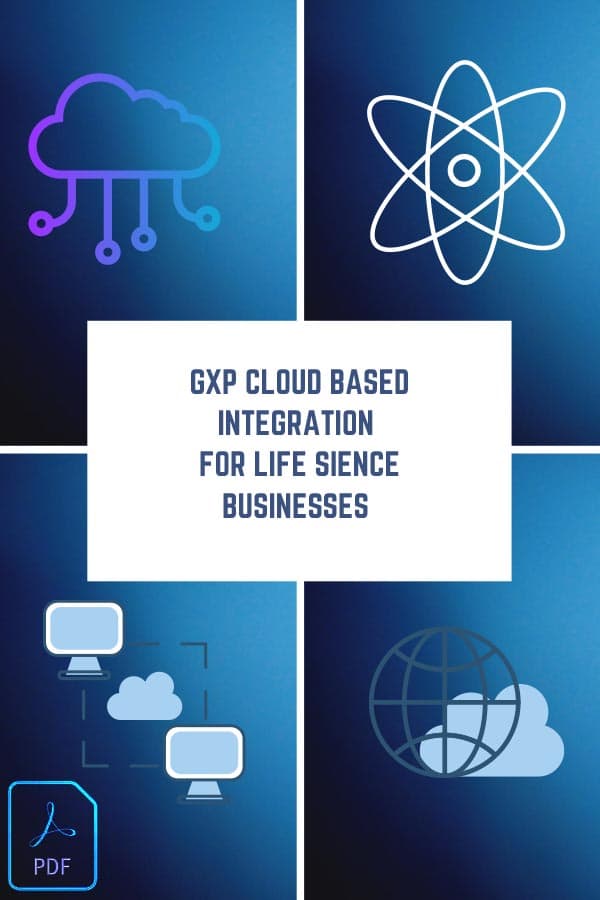Index
- What is cloud computing?
- Background on cloud computing
- Why has it emerged for companies
- Challenges of implementation in GxP and Life Science Businesses
- How to create value with cloud computing
- Threats of cloud computing
- SWOT cloud computing
- Conclusions
- References
What is cloud computing?
Cloud Computing is an on-demand computer system resource that provides data storage and processing power services.
Life-sciences companies are generating new paths to business value through efficiencies that cloud migrations typically target. Life Science companies are also dealing with big data and GxP principles, for which support of powerful tools (such as cloud computing) can improve the velocity of process implementation and application.
Background on cloud computing
Cloud storage emerged as a support for digitalization and big data, providing storage places and the possibility to access the pool from multiple devices and locations and be accessible to multiple users.
We probably couldn’t make our world work without cloud storage – think of multinational companies that need to share, spread and process data from multiple locations; when it comes to big data, storing, working and mailing tangible documents is unlikely to be as efficient.
And this applies to big and smaller corporations, especially when the subject is a life science company: with the presence of regulating agencies, such as the FDA (Food and Drug Administration), and the development and integration of GxP, cloud computing have found fertile ground.
Cloud storage is a model on servers (computers) in which digital data are stored in pools, “the clouds”. The data “exist physically” in multiple servers that are likely to be spread over various locations and are owned and managed by a hosting company. Cloud storage providers are responsible for keeping the data available, accessible, and secure.
People and organizations can buy or lease storage capacity from providers to store the company’s data.
Why has it emerged for companies?
Cloud Based Integration enables business innovation through automation, scalability, resilience, and data analytics improvements. Moreover, it reduces costs and human error.
In Life Science Businesses, enormous loads of data are processed. For instance, when a pharma company decides to invest in developing a new drug, it jumps into a long, expensive process. Everything starts with the discovery and the later development of a new drug, following up with clinical trials, and applying to FDA regulations, which usually takes years and billions of dollars. It’s a long journey from development to market selling. And every step, every little process, produces data, and data must be held, processed, analyzed, stored, shared, and secured. Data collection is speeding up the process in multiple ways, and cloud computing is a primary source that life science businesses can count on.
A core benefit of cloud computing is “scalability”: scaling an IT solution at a good pace. This is a crucial feature of cloud computing because since we’re talking about big data, having quick and relatively “easy” solutions can profoundly and positively affect business goals on multiple levels. Cloud computing is breaking down the barriers of old hardware setups and processing power. Thanks to clouds, the way businesses manage technical resources has been revolutionized.
As a positive consequence, businesses can count on faster innovation at the levels to which cloud computing is applied.
Businesses need to consider also budgeting, and although migration to the cloud might require a monetary effort, the finances saved in the future will fill the gap: businesses wouldn’t need to support as many IT systems anymore. This benefit comes along with a second one: data security is provided by a cloud computing hosting company, which will make businesses migrate finances to other departments and enhance or support other crucial processes.
Challenges of implementation in GxP and Life Science Businesses
Life Science Businesses work under strict regulations provided by official organizations, which require quality standards to ensure data safety: a mistake in a pharma company can lead to severe damage to patients and possible loss of human lives. FDA is among the significant agencies regulating medical products. Its authority covers the final product produced, for example, by a pharma company, but it has no regulating power over services provided by healthcare practitioners. Moreover, security is another big concern for FDA: with cloud computing, sensitive data about patients are transmitted wirelessly, exposing them to potential cyberattacks. All of the above gives FDA some challenges regarding regulating cloud computing.
Cloud computing is a rising concern since, with its many utilities, it has become a vital technology in electronic medical record systems and telemedicine solutions as well. The FDA has updated its regulations to help companies face cyberattacks and to ensure they have a guide when dealing with digital health. Also, patients must be informed about data vulnerability and guidelines about privacy policy are indeed provided.
Documents provided by the FDA are:
- Playbook for Threat Modeling Medical Devices
- Best Practices for Communicating Cybersecurity Vulnerabilities to Patients
- NIST Request on Presidential Executive Order: Comments Submitted by the FDA
- Strengthening Cybersecurity Practices Associated with Servicing of Medical Devices: Challenges and Opportunities
- Cybersecurity in Medical Devices: Quality System Considerations and Content of Premarket Submissions
- Content of Premarket Submissions for Management of Cybersecurity in Medical Devices
- Postmarket Management of Cybersecurity in Medical Devices
- Content of Premarket Submissions for Management of Cybersecurity in Medical Devices
- Cybersecurity for Networked Medical Devices Containing Off-the-Shelf (OTS) Software
These regulations concern digital health when patients’ data and records are stored in servers that cyberattacks of different kinds might threaten. A clear regulation regarding cloud computing support from external providers has yet to be produced. It can be assumed that it is accepted to the extent that data security is guaranteed.
How to create value with cloud computing?
Value after implementation of a cloud computing system can be created by:
- Upgrading IT systems to quickly work along the entire value chain, from early development to manufacturing, supply chain and customer engagement;
- Allowing for standardization of processes through simplification, optimization of supply chains and standardization of operation;
- Driving business innovation after structuring operating models around products/platforms and boosting development by setting up cross-functional teams that work in short iterative cycles;
- Capturing value from data by integrating end-to-end processes and standardizing workflow management;
- Scaling rapidly as application maintenance will only require a lean IT organization;
Threats of cloud computing
When moving to cloud computing, businesses can strengthen the security of their data: cloud computing hosting companies benefit from top-tier security services, but more security doesn’t mean zero chances of threats. Amongst the most significant risks, we can identify cybersecurity attacks, which have consequences.
Cloud computing hosting companies are designed to provide high-quality security and the power to process big data loads. This makes them the perfect setup to mine cryptos, and that’s exactly what crypto jacking refers to: by “stealing” processing power, miners can for sure mine cryptos, but as a downside, data processing of the business hosted in these servers will be slowed down.
Amongst the most dangerous cyberattacks, we find data breaches: which literally means a loss of data and potential misuse: cybercriminals can get unauthorized access to the network or view, copy and even send data. This is dangerous because it violates GDPR (General Data Protection Regulation) practices, and the business can be severely fined.
DoS (Denial of Service) is another threat that will mine the availability of the service both for the business and the business’ clients. This occurs when criminals flood the network system with a large amount of data, making it impossible for the server to handle and cope with all this data. DoS can damage a business if this is run or entirely relies solely on cloud computing.
Hijacking is another crucial issue regarding cloud computing: an employee can get their password cracked, or a cybercriminal can hijack using phishing emails. The best solution is to provide employees with the proper training to prevent data loss and misuse of access.
Even when employees are well-trained against cyber-attacks (e.g., phishing), a lack of security can be due to third-party applications used to process the stored data. In the latter case, the IT team should define which application should be downloaded and used for business purposes, preventing employees from downloading apps that haven’t been approved.
SWOT cloud computing
A good sum-up to better represent the pros and cons of cloud computing is to represent this in a SWOT analysis.
Strengths of Cloud Computing can be found, for example, in its structure; cloud computing allows for flexible and accessible use of data, along with the processing power of cloud servers. This, in turn, allows for faster innovation for businesses and an exponential expansion because the quantity of data that can be stored is huge. Cloud computing is also a cost-saving option: IT security departments are reduced since the hosting company provides data security. Costs are also reduced in terms of energy used by the company and server maintenance costs. Cloud computing can benefit from data being accessible from anyone and everywhere worldwide, which is a crucial feature for international companies working in multiple time zones.
Opportunities are found in its potential for innovation. Working in a high-tech environment, with the possibility to process data, innovation, revolution, and change flexibly can be implemented way more easily than when working with pen and paper or with smaller servers. Businesses can also provide last-tech solutions for clients, making them shine better on the market and quickly apply to changes in the field, which is critical for innovation.
Weaknesses are found in the difficulties of adapting to this kind of change. Employees must be trained to use the new platform when moving to a new hosting company. Another issue with it is the possibility of manually handling data and information; hence the business must be provided with a good internet connection when deciding to move digital or into the cloud. Otherwise, secondary issues might come up. Should a problem occur, the hosting company might also be unable to provide the server location where business info and data were stored.
Lastly, cloud computing comes also with some threats. With could computing, businesses rely solely on the hosting company; something should happen to that company. Also, the industry will have to face the consequences. This can be due to cyberattacks, temporary unavailability of servers and so on. Another threat is the possible difficulties (and costs) faced during migration from business servers to the cloud; there might be problems.
Conclusions
Cloud computing is a powerful tool that can boost innovation and make life easier for those working in big corporations. Like everything, it also comes with threats. On the one hand, paper theft and fire can be a threat; on the other, there are server malfunctions and cyberattacks. Every business should define its positioning on the market and decide whether the migration to the cloud can benefit, eventually, the performance of the company and if it can be of good help for reaching the company’s goal of enriching its vision.
We are living in the tech era, and companies now have the option to either align with modern apps and methods, develop their own, or go for old-fashioned ways – all following the company’s needs.
References
https://dl.acm.org/doi/fullHtml/10.1145/1364782.1364786
https://link.springer.com/chapter/10.1007/978-3-642-10665-1_63
https://link.springer.com/book/10.1007/978-3-319-54645-2
9 Reasons Why Cloud Computing Is Important For Business (sam-solutions.us)
How Data Collection in Pharma Is Evolving – The World Financial Review
Debunking seven common myths about cloud | McKinsey
7 Key Cybersecurity Threats to Cloud Computing – Cloud Academy
Author: Giulia Caseri, LIfe Science Consultant KVALITO
KVALITO is a strategic partner, global quality and compliance service, and network for regulated industries. To find out more, please visit us at www.kvalito.ch. If you would like to benefit from KVALITO’s expert services, please send us an email at contact@kvalito.ch. Are you looking for an exciting and challenging position as a consultant, or you are an ambitious student/graduate looking for an internship? Please send your complete application to recruiting@kvalito.ch.






